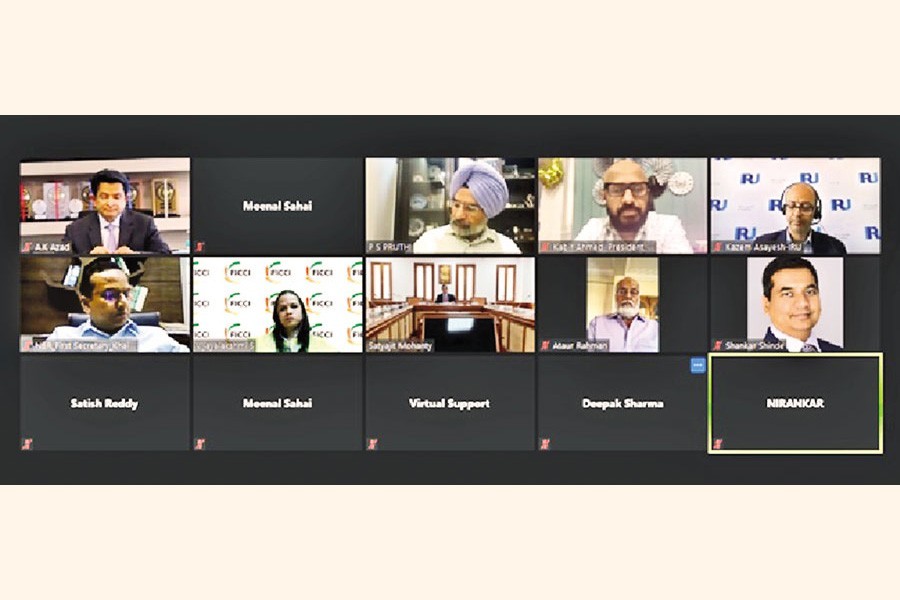Speakers at a webinar on Thursday said movement of vehicles within the BBIN region under a system like that of the UN TIR would help significantly reduce the cost of trade and benefit all the member countries.
The TIR stands for "Transports Internationaux Routiers" or "International Road Transport". Bangladesh is not a signatory country of the TIR.
Uniform and harmonised customs procedure of Bangladesh and India would also help boost bilateral trade, said the speakers from the two countries.
They, however, stressed the need for conducting more studies on the introduction of such system as the two next-door neighbours share a unique trade relation.
The International Chamber of Commerce-Bangladesh (ICC-B), the Federation of Indian Chambers of Commerce and Industry (FICCI) and Geneva-based International Road Transport Union (IRU) jointly organised the webinar titled "UN TIR system and its benefits of expansion to Bangladesh and other BBIN (Bhutan, Bangladesh, India and Nepal) countries".
The TIR aims to facilitate free movement of goods under customs control across the international borders, without any interference or cross-border checks.
It plays an important role in facilitating cross-border trade flow, adding considerable value to improving regional trade mechanisms.
It is governed by the United Nations Economic Commission for Europe (UNECE) and managed by the world road transport organisation, IRU.
Speaking at the webinar, vice president of ICC-B AK Azad said the trade procedures of customs and transit are made uniform and harmonised among the BBIN countries by bringing them under the umbrella of a single agreement like TIR.
"It would hugely cut the costs and improve the trade relations and productivity of this region," he said.
He said the TIR conventions along with other global standards would help effective implementation of the BBIN agreement.
"Further, the intermodal aspect of TIR system that encompasses rail, sea and air would also play an important role in connecting this region to the world," he added.
Mr. Azad said that lying in close proximity to each other and sharing borders by BBIN, have made it inevitable for the countries to trade among each other as it is very important and productive for their economies.
"However, the current trade procedure and practices incur huge costs to these countries and the geographical closeness factor is not fully utilised for growth," he said.
He said that intraregional trade accounts for barely 5.0 per cent of South Asia's total trade as compared to the ASEAN region where intraregional trade makes up 25 per cent.
"Trade among South Asian countries currently totals just $23 billion - far below an estimated value of at least $67 billion," he further said.
With reference to a latest World Bank report titled 'Connecting to Thrive: Challenges and Opportunities of Transport Integration in Eastern South Asia', the ICC-B vice president said a seamless transport connectivity between India and Bangladesh has the potential to increase national income by as much as 17 per cent in Bangladesh and 8 per cent in India.
Welcoming the initiative, first secretary (Customs: International Trade and Agreement) of the National Board of Revenue (NBR) of Bangladesh Md. Khairul Kabir Mia stressed the need for further research and studies on the implementation of the convention.
He said the bilateral trade relation between India and Bangladesh is unique and different from many other countries in the world that adopted the system.
Mr. Kabir, however, pointed out that it is not yet sure whether the system would be better alternative to the existing system in place for trading with India. "We look forward to it, but more studies are required," he added.
Joint secretary and commissioner of customs, CBIC, Ministry of Finance of India, Satyajit Mohanty said the exports of Bangladesh could increase 300 per cent and that of India's 170 per cent if the system is introduced.
He pointed out the existing difficulties that it takes around 100 hours to cross the border at Petrapole.
Mohanty said the BBIN countries have different means and procedure for trade. He added that the existing trading system and TIR can be produced simultaneously to examine which one is better. "It will be a win-win situation for all parties."
Senior advisor of IRU, Geneva Kazem Asayesh said India and Bangladesh could use TIR for transportation of goods by sea, rail and in inland waterways. A study on TIR benefits for BBIN shows that TIR will significantly contribute to the implementation of the agreement.
Other corridors such as BCIM and BIMSTC routes could be activated under the TIR system. Asian Development Bank (ADB) consultant Satish Kumar Reddy said it is very difficult to say whether TIR is the superior alternative to what BBIN countries are now doing.
"But it is a good alternative," he said, adding that the BBIN countries could give it a try.
Shankar Shinde, chairman-elect of the Federation of Freight Forwarders' Associations in India (FFFAI), Kabir Ahmed, president of Bangladesh Freight Forwarders' Association (BAFFA), PS Pruthi, senior consultant of FICCI and former member of Customs Excise & Service Tax Appellate Tribunal (CESTAT), and Ataur Rahman, secretary general of ICC-B, among others, spoke at the webinar.


